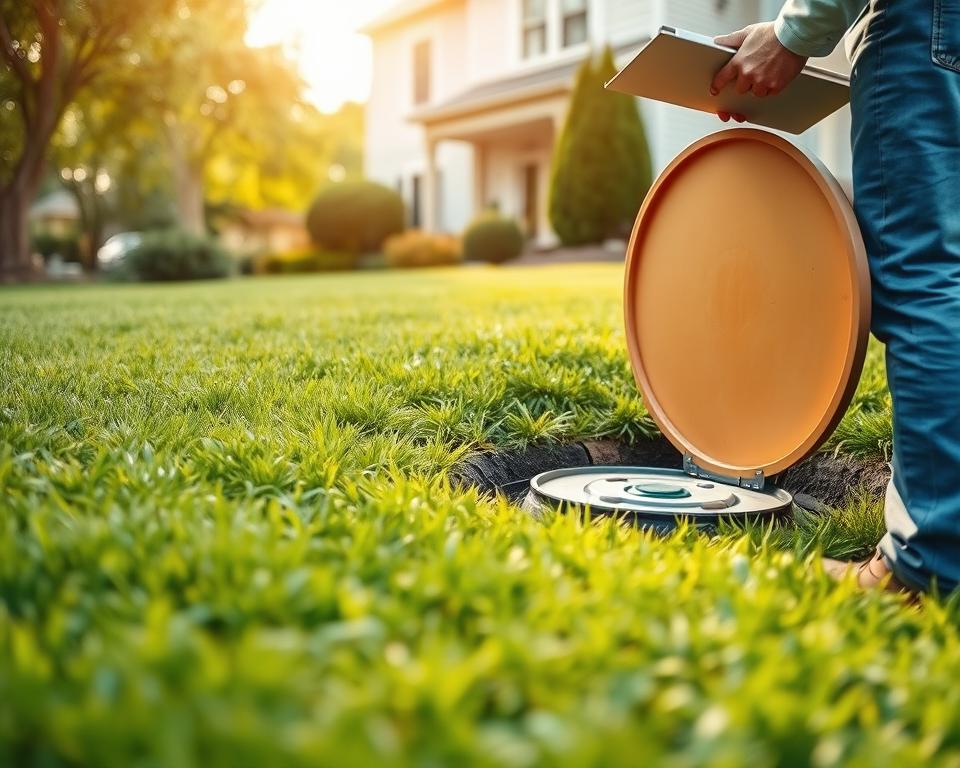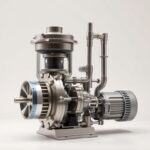Septic Aerator Pump: Must-Read Guide for Homeowners
Do you sometimes think about what powers your air-treated Septic system’s performance? The air unit in your Septic system is the unsung champion indispensable for your system. With this resource, readers will gain essential knowledge on the aerator’s role. It’s essential for a healthy, optimized Septic system.
Knowing the necessity of a Septic tank air Pump can optimize your Septic system’s capabilities using septic tank pumping prices. It also preserves your real-estate worth and environmental health. Our handbook will present All in Sanitation, a reputable Septic industry leader. They’re ready to serve your Septic aerator Pump needs.
Key Takeaways
- The Septic air Pump is crucial for aerobic Septic systems.
- Properly caring for your Septic system air Pump can improve overall system efficiency.
- Periodic reviews increase the longevity of your Septic tank air Pump.
- Selecting the right Septic aerator Pump is necessary for optimal operation.
- All in Sanitation offers expert services for Septic air Pump support.
Breaking Down Aerobic Septic Setups
Aerobic Septic systems present a superior waste treatment method by using oxygen. This process employs aerobic bacteria flourishing in well-oxygenated environments. These bacteria are better in breaking down organic matter. With the help of Septic aerator Pumps, these systems provide a constant oxygen supply, boosting the waste decomposition process.
These systems shine in lowering sludge buildup, owing to the effectiveness of aerobic bacteria. This cut in solid waste means minimal cleaning and tank Pump-outs is required less often. Additionally, they efficiently treat wastewater, creating reduced odors. This creates a healthier environment for homeowners and the community overall.
To ensure these systems operate efficiently, it’s necessary to know the key Septic system components. These include the Septic tank, aeration chamber, and effluent Pump. Each component is vital, especially the air Pump. It pushes oxygen into the tank, central for the aerobic bacteria’s performance.
Significance of the Septic Air Pump
The Septic air Pump is central in the running of aerobic Septic systems. It serves as the system’s “lungs,” delivering the critical oxygen required. This oxygen permits aerobic bacteria to prosper and decompose waste properly. If the Pump breaks, the system’s performance decreases, bringing about sludge buildup and possible odors.
Such issues can disrupt Septic system operations and lead to environmental hazards. By understanding how important the Septic air Pump is, homeowners can move early. They can secure its best function through consistent upkeep. This avoids failures, avoids costly repairs, and protects the aerobic system’s condition.
Key Benefits of Using a Septic Air Pump
Running a Septic air Pump greatly improves the efficiency of Septic systems. Septic air Pumps are crucial as they speed up the breakdown of waste. This is realized by oxygenating the treatment process, promoting aerobic bacteria growth. These bacteria are essential for effective waste treatment.
They’re also useful in lowering foul smells. Due to more active aerobic processes, waste breaks down faster, thus lessening odors. This provides a fresher environment for homeowners.
Another significant benefit is the drop in sludge accumulation. Consequently, tanks require less frequent Pumping, cutting both money and time. Enhanced processing not only reduces spending but also increases the lifespan of the drain field.
Servicing these Pumps correctly means minimal repair costs and complying with regulatory standards. Thus, the upsides of Septic air Pumps are not only for homeowners. They also enhance environmental health by raising waste management practices.
| Benefit | Description |
|---|---|
| Fast Waste Breakdown | Increased aerobic activity hastens the decomposition process. |
| Minimized Odor Emissions | Optimized treatment efficacy leads to fewer odors. |
| Reduced Sludge Buildup | Less frequent Pumping and maintenance are required. |
| Extended Drain Field Life | Better treatment ensures a healthier drain field. |
| Cost Savings | Lower probability of repairs and regulatory compliance cost. |

Picking an Ideal Septic Air Pump
Selecting the proper Septic air Pump is essential for an efficient aerobic system. Homeowners should assess various factors for the perfect selection. The capacity of the tank and the airflow specifications matter greatly the Pump’s effectiveness.
To select well, it’s essential to know the air Pumps available. There are mainly two types: diaphragm Pumps and rotary vane Pumps. Each comes with particular pluses, which should be paired with your home’s specific needs and daily load.
Electric efficiency also is a factor. Choosing a Pump that minimizes energy use while supplying the needed airflow can offer meaningful reductions. Guidance from All in Sanitation professionals can be extremely useful. They verify the Pump you choose meets your system’s requirements seamlessly.
Major Kinds of Septic Air Pumps
Homeowners can decide more effectively by understanding the distinct Septic air Pumps available. There are mainly two types: diaphragm Pumps and rotary vane Pumps. Each has its particular functions and benefits.
Diaphragm Pumps, known for their low-noise operation, are commonly used for residential Septic systems. They provide energy efficiency while ensuring stable air output. Their dependable performance matches smaller systems, preferred by many homeowners.
Rotary vane Pumps, however, are ideal for higher-capacity or commercial systems. These Pumps provide more power, required when handling bigger loads. Their robust build allows efficient operation in extensive Septic systems.
| Type of Pump | Best Use | Advantages |
|---|---|---|
| Diaphragm Pumps | Residential Systems | Quiet operation, energy-efficient, reliable air flow |
| Rotary Vane Pumps | Larger or Commercial Systems | Powerful performance, high capacity, durable construction |
Recognizing the distinctions in Septic air Pumps is key for upgrades or replacements. Each Pump type provides particular attributes to address various needs. This provides peak performance for any system.
How to Tell You Need a Septic Air Pump Replacement
Homeowners must monitor Pump failure signs in their Septic systems. Some clues indicate the need for a Septic air Pump replacement. These keep the system running smoothly. Catching these early avoids major issues.
Signs of potential problems include:
- Unusual noises from the Pump, like grinding or trembling, might mean internal damage.
- A clear lack of air output suggests the Pump isn’t performing as intended, harming efficiency.
- Repeated electrical problems, such as circuit trips or flickering lights, could indicate overloading.
- Visible damage on the Pump unit, with breaks or leaks, requires quick action.
- Unpleasant odors in the yard often reveal a compromised Pump, highlighting ineffective effluent aeration.
Spotting these signs early stops costly fixes or total system failure. Performing routine inspections helps identify these issues. It also demonstrates if you require a new Septic air Pump.
Maintenance Tips for Your Septic Air Pump
For an optimal Septic air Pump, periodic care is necessary. This ensures that that your system functions properly. Homeowners can follow several practical care strategies for peak results.
Twice a year, perform a comprehensive inspection for wear or damage. It is also essential to renew the filters as recommended. This stops clogs that could hamper efficiency.
The Pump should rest on a stable base to cut vibrations, which could affect it over time. A protective cover is vital too. It defends against debris and water, maintaining the Pump’s functionality.
Diligent care can greatly lengthen the life of your Pump. In turn, this benefits the Septic system’s performance in general.
| Maintenance Task | Frequency | Benefits |
|---|---|---|
| Inspect Pump for damage | Every 6 months | Catches problems quickly |
| Replace filters | As needed | Improves efficiency |
| Check surface stability | Annually | Reduces vibrations |
| Clear debris around Pump | Monthly | Prevents clogs |
Fitting Your Septic Air Pump
Proper installation of your Septic air Pump is essential for its smooth operation. Initially, select a secure, moisture-free area for placement. The chosen spot should safely support the Pump’s weight with ease.
To properly fit your Pump on your own, use the following guidelines:
- Gather all necessary items, including the Pump, a power source, and hose fittings.
- Thoroughly review the manufacturer’s guidelines before kicking off your installation.
- Make sure every connection is sealed to prevent air leaks that compromise performance.
- After assembly, conduct a test to confirm the system works as intended.
If the installation process seems daunting, contact All in Sanitation. Their professionals can sidestep common errors, confirming your setup adheres to necessary safety requirements.
Reasons to Select All in Sanitation for Your Septic Air Pump Solutions
When deciding on a Septic service provider, the choice is significant. All in Sanitation distinguishes itself by supplying dependable Septic air Pumps. They satisfy diverse homeowner requirements with a wide selection of quality products. This ensures customers get an ideal match for their Septic systems.
What clearly distinguishes All in Sanitation is beyond their extensive product lineup. Their devotion to exceptional customer service is equally significant. Homeowners receive professional guidance, helping them choose trusted Septic solutions. This partnership is key to tailor each solution to fulfil specific needs.
All in Sanitation also focuses on aftercare to guarantee lasting satisfaction. Their promise extends beyond the initial sale. They deliver ongoing support to preserve Septic systems running smoothly for the foreseeable future.
Expense Overview for Septic Air Pumps
Knowing the expenses tied to Septic air Pumps is important for homeowners using aerobic Septic systems. To start, one faces the purchase price, which includes the Pump and needed accessories. Installation expenses differ, based on the system’s complexity and any alterations required.
Ongoing upkeep forms an additional cost layer. Consistent assessments can fend off bigger issues, in the long run yielding savings. Homeowners should allocate money for Septic maintenance to retain the Pump’s effectiveness and durability. Such planning prevents expensive repairs later on, highlighting the value of proactive maintenance.
| Cost Component | Average Cost Range |
|---|---|
| Septic Air Pump | $500 – $1,200 |
| Installation | $300 – $800 |
| Annual Maintenance | $150 – $400 |
| Potential Repair Costs | $1,000 – $5,000 |
Itemizing Septic air Pump expenses into separate parts aids homeowners in cost forecasting. This comprehensive approach provides the system’s steady performance and their comfort.
Conclusion
For homeowners with aerobic Septic systems, caring for Septic tanks is vital. The suitable Septic air Pump optimizes waste processing and lengthens your system’s life. Committing to ongoing care and swiftly handling issues stops high expenses and disruptions.
Picking a Septic air Pump warrants careful thought. This guide highlighted how to decide intelligently about installation and replacement. With All in Sanitation’s support, you can navigate your Septic systems’ complexities securely.
Attending to your Septic air Pump promotes your system’s performance and life span. It guarantees a trouble-free and proper operation over time. Keep in mind, your home’s wastewater management relies heavily on ongoing maintenance.

